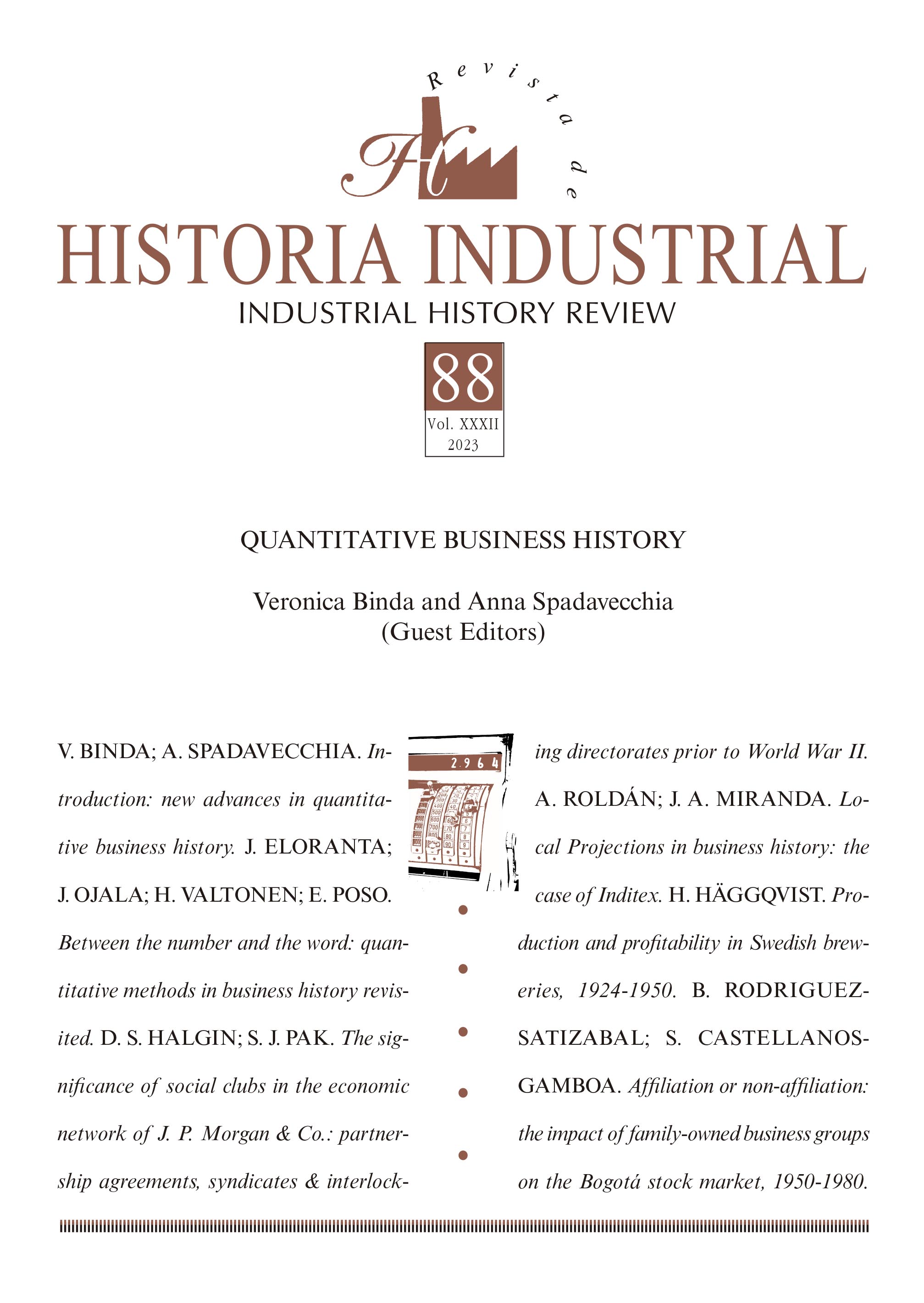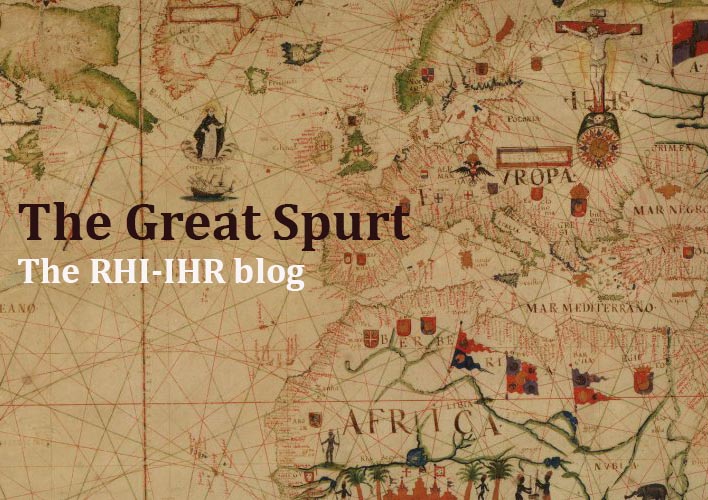Local Projections in business history: the case of Inditex
DOI:
https://doi.org/10.1344/rhiihr.40667Keywords:
local projections, quantitative methods, business history, fast fashionAbstract
This article has two objectives. On the one hand, it attempts to delve into the sources of competitive advantage of Inditex, the world’s largest clothing retailer, by considering the evolution of the company’s strategies over the last two decades and relying on an econometric technique, Local Projections, to complement the qualitative analyses. On the other hand, the article presents and explains this quantitative technique, which can help to solve some of the problems that arise when attempting to apply quantitative methods in business history, such as small sample sizes, causality analysis or endogeneity.
Downloads
References
Alonso, Luis. 2000. ‘Vistiendo a tres continentes: la ventaja competitiva del grupo Inditex-Zara, 1963-1999’, Revista de Historia Industrial, 18: 157-182.
Alonso, Luis. 2011. ‘Competitividad internacional e innovación tecnológica. El grupo Inditex 1985-2009’. In Distritos y clusters en la Europa del sur, edited by Jordi Catalan, José Antonio Miranda, and Ramon Ramon-Muñoz, 337-350. Madrid: LID.
Barnes, Liz, and Gaynor Lea‐Greenwood. 2006. ‘Fast fashioning the supply chain: shaping the research agenda’. Journal of Fashion Marketing and Management: An International Journal, 10 (3): 259-271.
Barnich on, Regis, and Christian Brownlees. 2016. ‘Impulse Response Estimation by Smooth Local Projections’, CEPR Discussion Paper 11726. London: Centre for Economic Policy Research. https://ideas.repec.org/p/cpr/ceprdp/11726.html
Bazot, Guillaume, Eric Monnet, and Matthias Morys. 2022. ‘Taming the global financial cycle: central banks as shock absorbers in the first era of globalization’, The Journal of Economic History, 82 (3): 801-839.
Blanco, Xabier R., and Jesús F. Salgado. 2004. Amancio Ortega. De cero a Zara. Madrid: La esfera de los libros.
Brugnolini, Luca. 2018. ‘About local projection impulse response function reliability’, CEIS Working Paper 440. Roma: Università di Roma Tor Vergata.
Cach on, Gérard P., and Robert Swinney. 2011. ‘The Value of Fast Fashion: Quick Response, Enhanced Design, and Strategic Consumer Behavior’, Management Science, 57 (4): 778-795.
Caro, Felipe, and Víctor Martinez-de-Albeniz. 2015. ‘Fast Fashion: Business Model Overview and Research Opportunities’. In Retail Supply Chain Management. International Series in Operations Research & Management Science, edited by Narendra
Agrawal, and Stephen A. Smith, 237-264. Berlin: Springer.
Crofton, Stephanie, and Luis Dopico. 2007. ‘Zara-Inditex and the Growth of Fast Fashion’, Essays in Economic and Business History, 25 (1): 41-54.
De Barron, Íñigo. 2021. ‘El nuevo consejero delegado de Inditex, un jurista curtido en la banca que llega con el estilo de Pablo Isla’. El País, 1 December 2021. https://elpais.com/economia/2021-12-01/el-nuevo-jefe-de-inditex-un-jurista-curtido-en-labanca-que-llega-con-el-estilo-de-pablo-isla.html
Demiralp, Selva, and Kevin D. Hoover. 2003. ‘Searching for the causal structure of a vector autoregression’, Oxford Bulletin of Economics and statistics, 65 (6): 745-767.
Divita, Lorynn R., and Jeong-Ju Yoo. 2017. ‘Examining global retailing’s innovators: An overview of fast fashion supply chain research’. In Fast Fashion Systems. Theories and Applications, edited by Tsan-Ming Choi, 24-36. London: CRC Press.
Eloranta, Jari, Jari Ojala, and Heli Valtonen. 2008. ‘Are Business Historians Quantitatively Illiterate?’. Bergen: European Business History Association Conference on Transactions and Interactions: The Flow of Goods, Services, and Information. https://ebha.org/ebha2008/papers/Eloranta-Ojala-Valtonen_ebha_2008.pdf
Eloranta, Jari, Jari Ojala, and Heli Valtonen. 2010. ‘Quantitative methods in Business history: An impossible equation?’, Management & Organizational History, 5 (1): 79-107.
Ferdows, Kasra, Michael A. Lewis, and Jose A. D. Mach uca. 2004. ‘Rapid-Fire Fulfillment’, Harvard Business Review, 82 (11): 104-110.
Friedman, Walter A., and Geoffrey Jones. 2011. ‘Business history: Time for debate’, Business History Review, 85 (1): 1-8.
Galindo, Cristina. 2022. ‘Inditex culmina el relevo generacional con la llegada de Marta- Ortega a la presidencia’. El País, 1 April 2022. https://elpais.com/economia/2022-03-31/inditex-culmina-el-relevo-generacional-con-la-llegada-de-marta-ortega-a-la-presidencia.html
Gestal, Iria. P. 2023. ‘H&M se acerca al modelo Inditex: IA y relocalización para ganar velocidad’. Modaes, 30 January 2023. https://www.modaes.com/empresa/hm-se-acerca-al-modelo-inditex-ia-y-relocalizacion-para-ganar-velocidad
Ghemawat, Pankaj. 2002. ‘Competition and Business Strategy in Historical Perspective’, Business History Review, 76 (1): 37-74.
Giertz-Manterson, Ingrid. 2018. ‘H&M: how Swedish entrepreneurial culture and social values created fashion for everyone’. In European fashion. The creation of a global industry, edited by Regina Lee Blaszczyk and Véronique Pouillard, 201-219. Manchester: Manchester University Press.
Gupta, Shipra, and James W. Gentry. 2018. ‘Evaluating fast fashion’. In Eco-friendly and Fair: Fast Fashion and Consumer Behaviour, edited by Carolin Becker-Leifhold and Mark Heuer, 69-92. London: Routledge.
Hidy, Ralph W. 1970. ‘Business history: Present status and future needs’, Business History Review, 44 (4): 483-497.
Hill, Charles W. L. 1988. ‘Differentiation Versus Low Cost or Differentiation and Low Cost: A Contingency Framework’, Academy of Management Review, 13 (3): 401-412.
H&M Group. 2005. Annual report 2004. Stockholm: H&M Hennes & Mauritz AB. https://hmgroup.com/wp-content/uploads/2020/10/Annual_Report_2004_en.pdf
H&M Group. 2020. Annual report 2019. Stockholm: H&M Hennes & Mauritz AB. https://hmgroup.com/wp-content/uploads/2020/10/HM_Annual-Report-2019.pdf.
Inditex. 1999. 1998 Informe anual Grupo Inditex. Arteixo: Grupo Inditex.
Inditex. 2001. Informe anual 2000. Arteixo: INDITEX SA.
Inditex. 2002. Informe anual 2001. Arteixo: INDITEX SA.
Inditex. 2020. Memoria anual 2019. Arteixo: Dirección General de Comunicación y Relaciones Institucionales. Inditex SA. https://www.inditex.com/itxcomweb/api/media/494d7639-354b-4aab-98a3-5d1933888750/memoria_grupo_inditex_2019.pdf?t=1655306346313
Inditex. 2021. Memoria Anual del Grupo Inditex. Ejercicio Social 2020. Arteixo: Dirección General de Comunicación y Relaciones Institucionales. Inditex SA. https://www.inditex.com/itxcomweb/api/media/186b228a-cf0c-4d1a-bb68-9ed36f8300ac/memoria_anual_inditex_2020.pdf?t=1655306361345
Inditex. 2022. Memoria Grupo Inditex 2021. Arteixo: Inditex SA. https://www.inditex.com/itxcomweb/api/media/391106a6-1536-4306-b849-1b0a02a2d59a/memoria_grupo_inditex_2021.pdf?t=1655306387148
Jones, Geoffrey, and Tarun Khanna. 2006. ‘Bringing history (back) into International business’, Journal of International Business Studies, 37 (4): 453-468.
Jones, Geoffrey, Marco H. Van Leeuwen, and Stephen Broadberr y. 2012. ‘The future of economic, business, and social history’, Scandinavian Economic History Review, 60 (3): 225-253.
Jorda, Òscar. 2005. ‘Estimation and inference of impulse responses by local projections’, American Economic Review, 95 (1): 161-182.
Jorda, Òscar, Sanjay R. Singh, and Alan Taylor. 2020. ‘The long economic hangover of pandemics: History shows COVID-19’s economic fallout may be with us for decades’, Finance & development, June: 12-15.
Kogut, Bruce, and Charles Ragin. 2006. ‘Exploring complexity when diversity is limited: Institutional complementarity in theories of rule of law and national systems revisited’, European Management Review, 3 (1): 44-59.
Lutkepohl, Helmut. 2010. ‘Impulse response function’. In Macroeconometrics and time series analysis, edited by Stephen N. Durlauf and Lawrence E. Blume, 145-150. London: Palgrave Macmillan.
Lutkepohl, Helmut. 2013. ‘Vector autoregressive models’. In Handbook of research methods and applications in empirical macroeconomics, edited by Nigar Hashimzade and Michael A. Thornton, 139-164. Cheltenham: Edward Elgar Publishing.
Lutkepohl, Helmut, Markus Kratzig, and Dmitri Boreiko. 2006. VAR analysis in JMulTi. Online-help chapters for JMulTi. http://www.jmulti.de/download/help/var.pdf
MacCarthy, Bart L., and P. G. S. A. Jayarathne. 2009. ‘Fast Fashion: Achieving Global Quick Response (GQR) in the Internationally Dispersed Clothing Industry’. In Springer Handbook on Innovative Quick Response Programs in Logistics and Supply Chain Management, edited by T. C. Edwin Cheng, and Tsang-Ming Choi, 37-60. Berlin: Springer.
Miranda, José Antonio. 2020. ‘The country-of-origin effect and the international expansion of Spanish fashion companies, 1975–2015’, Business History, 62 (3): 488-508.
Miranda, José Antonio, and Alba Roldan. 2021. ‘Inditex y la ventaja competitiva de la fast fashion española, 1985-2019’, Dimensioni e Problemi della Ricerca Storica, 2: 155-178.
Montiel Olea, José Luis., and Mikkel Plagborg‐Moller. 2021. ‘Local projection inference is simpler and more robust than you think’, Econometrica, 89 (4), 1789-1823.
Pertusa-Ortega, Eva M., José F. Molina-Azorin, and Enrique Claver-Cortes. 2009. ‘Competitive strategies and firm performance: a comparative analysis of pure, hybrid and ‘stuck-in-the-middle’ strategies in Spanish Firms’, British Journal of Management, 20 (4): 508-523.
Pesaran, Hashem, and Yongcheol Shin. 1998. ‘Generalized impulse response analysis in linear multivariate models’, Economics Letters, 58 (1): 17-29.
Plagborg‐Moller, Mikkel, and Christian K. Wolf. 2021. ‘Local projections and VARs estimate the same impulse responses’, Econometrica, 89 (2): 955-980.
Porter, Michael E. 1980. Competitive Strategy: Techniques for Analyzing Industries and Competitors, New York: Free Press.
Porter, Michael E. 1985. Competitive Advantage: Creating and Sustaining Superior Performance, New York: Free Press.
Raff , Daniel. 2013. ‘How to do Things with Time’, Enterprise & Society, 14 (3): 435-466.
Ramey, Valerie A. 2016. ‘Macroeconomic shocks and their propagation’. In Handbook of macroeconomics. Volume 2, edited by John B. Taylor and Harald Uhlig, 71-162. Amsterdam and Oxford: Elsevier.
Salavou, Helen E. 2015. ‘Competitive strategies and their shift to the future’, European Business Review, 27 (1): 80-99.
Shephard, Arlesa, and Sanjukta Pookulangara. 2017. ‘The slow fashion process: Rethinking strategy for fast fashion retailers’. In Fast Fashion Systems. Theories and Applications, edited by Tsang-Ming Choi, 9-23. London: CRC Press.
Sojo, Francisco José. 2012. ‘Evolución y mejora en la competitividad de las empresas del sector textil-confección’, Economía industrial, 385: 39-46.
Stolbov, Mikhail, and Maria Shch epeleva. 2021. ‘Macrofinancial linkages in Europe: Evidence from quantile local projections’, International Journal of Finance & Economics, 26 (4): 5557-5569.
Sull, Donald, and Stefano Turc oni. 2008. ‘Fast fashion lessons’, Business Strategy Review, 19 (2): 4-11.
Taplin, Ian. 2014. ‘Global Commodity Chains and Fast Fashion: How the Apparel Industry Continues to Re-Invent Itself ’, Competition & Change, 18 (3): 246-264.
Tokatli, Nebahat. 2008. ‘Global sourcing: insights from the global clothing industry –the case of Zara, a fast fashion retailer’, Journal of Economic Geography, 8 (1): 21-38.
Wei, Zhenxiang, and Lijie Zhou, L. 2013. ‘E-Commerce Case Study of Fast Fashion Industry’. In Intelligence Computation and Evolutionary Computation. Advances in Intelligent Systems and Computing, edited by Zhenyu Du, 261-270. Berlin: Springer.
Downloads
Published
How to Cite
Issue
Section
License
Copyright (c) 2019 Revista de Historia Industrial – Industrial History Review

This work is licensed under a Creative Commons Attribution 4.0 International License.
We have been applying a Creative Commons Attribution license (CC-BY) since 2019, before that year we had a partial open access policy, which included open access for the first two months after publication, followed by an embargo policy for non-subscribers, as access to the last 4 published issues was restricted to journal subscribers. In contrast, early-view articles were always open access prior to publication in an assigned volume. Until 2024 the access to the last 4 published numbers was restricted to those who were subscripted to the journal.
The author assigns all rights to the publisher. Creative Commons
The author who publishes in this journal agrees to the following terms:
- The author assigns all intellectual property rights exclusively to the publisher for the entire duration of the applicable intellectual property rights. The University of Barcelona holds the copyright ownership of the contents published in the journal.
- The publisher will distribute the texts under the Creative Commons Attribution License, which allows others to share the work, provided that they acknowledge the authorship, its initial publication in this journal, and the conditions of the license.





